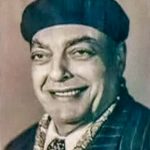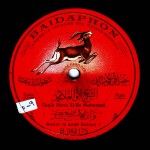Amar Foundation presents: Min Al-Tarikh
Mustafa Said: Welcome to a new episode of Min Al-Tarikh. We have with us Frederique Afandi Lagrange.
Frederique Lagrange: {Joking} haven’t I yet got the Beylik after all this time?
M: {joking} wow!!! His highness Frederique Lagrange Pasha minister of Culture.
M: {seriously” Today’s episode is about El-Sheikh Zakariyya Ahmed.
F: El-Sheikh Zakariyya Ahmed’s life is luckily for us well-documented, there is a number of sources, unlike the other music composers who began by the end of the 19th century or even unlike Dawoud Husni, who doesn’t belong to the very same generation of El-Sheikh Zakariyya, yet still the information about him and about Ibrahim El-Qabbani for instance is rather poor. As for El-Sheikh Zakariyya Ahmed, thankfully, we have sources.
M: And despite these sources, there are still legends.
F: Of course, whenever there is information, there has to be a legendary part. First, in Victor Sahhab’s book The Big Seven there is a section of the book about Zakariyya Ahmed. In this section he collects almost all the previous sources including Sabri Abul-Magd, Ni’mat Ahmed Fouad’s book about Om-Kolthoum, Mahmud Kamil and also the radio interviews with Sheikh Sayyid Mikkawi in which he spoke about Zakariyya Ahmed. So, we know almost everything about his professional career: we know that his father was Ahmed Saqr from Fayyoum but left for Cairo; we also know that Zakariyya Ahmed was born in Cairo in 1896; we know also that Zakariyya was rather a failure in his education and that he was dismissed from Al-Azhar and couldn’t continue his education there. The title Sheikh to his name is used like most of his generation to indicate that he studied in Al-Azhar for a certain period of time without getting the Aalamiyya (knowledge) degree from Al-Azhar, and also it indicates that he adopted the religious chanting following his dismissal from almost all the schools to which his father sent. He took to singing, first a religious chanter then he became a secular singer. It seems that he studied with Sheikh Darwish Al-Hariri. Whenever I read in the sources that Darwish Al-Hariri was the only master of Muwashshahat and religious Tawasheeh, I feel puzzled. Whenever I return to the Cairo 1932 Arab Music Conference records by Darwish El-Hariri, I get the impression that they’re not especially musical. I don’t know your opinion regarding that matter.
M: Sheikh Darwish El-Hariri was like an information box, a box of Muwashshahat. He knew by heart what had already been forgotten and what was nearly forgotten by then, and it seems that he knew a great deal more than what he recorded during the conference, yet as a voice, it is to be listened to only for memorisation. I think that Darwish Al-Hariri’s records for the conference are made for this very specific purpose.
F: You mean the educational purpose?
M: Exactly, to preserve them.
F: Anyway, it seems that Zakariyya Ahmed studied with Darwish Al-Hariri and with others who had great vocal capabilities: he studied with Sheikh Ismail Sukkar and he was a member of Sheikh Ali Mahmud’s Bitana (Choir), and sure enough, he must have learned a great deal from them.
M: even in the peak of his fame Sheikh Zakariyya was always with Sheikh Ali Mahmud’s Bitana until Sheikh Ali’s last records in 1944, I mean the last records we have after which others may exist, but in these 1944 records we can still hear Sheikh Zakariyya’s voice clearly in Sheikh Ali’s Bitana.
[Part of a recording by Sheikh Ali Mahmud and his Bitana].
F: it seems that his professional upbringing was mostly in the world of chanting as he memorized a great deal of Anashid (hymns) and Tawasheeh which used to be performed in the different religious occasions. This did not stop him from secular singing. I would like to read a short passage from Victor Sahhab’s book, and have your opinion about. He states on page 96: “As time passed, he started to avoid the religious chanting and get attracted to (secular) Music and Tarab so much so that Sheikh Darwish Al-Hariri failed to make him memorise the Quran, so he made him memorise certain Quranic verses which suit specific occasions. He wished for a different direction, so he went to Mohammed Al-Qasabgi to study how to play Oud with him.”. We have a couple of things here: first, that Sheikh Zakariyya Ahmed studied Oud with Mohammed El-Qasabgi, how do you think?
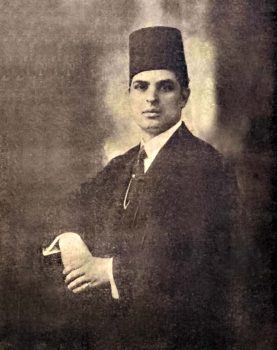
Abdel-Latif Al-Banna
M: In the TV interview with Abdel-Latif Afandi Al-Banna, he stated that when he came to Cairo from the north of Egypt, he formed a Bitana which included Sheikh Zakariyya Ahmed. Later on, at the time when he was composing the music for songs like Irkhi El-Sitara Elli fi Rihna he simultaneously composed religious Tawasheeh for different chanters with Baidaphone and Polyphone. Then, with Colombia and His Master’s, with the advent of electrically recorded disks, he also composed various tawasheeh for a number of chanters amongst which there’s a Tawsheeh entitled Ya Aal Najd chanted by Sheikh Ali Al-Harith of which only a short extract remained orally with a number of chanters. He even composed Tawasheeh for Sheikh Ibrahim El-Farran and others until even Sheikh Mohammed Hassan El-Nadi. That means that throughout his professional career, he never refrained from religious chanting. As for what is said about the Oud, I have no historical evidence that contradicts this information, yet, listening to his style of playing the Oud, I can hardly believe that he studied with Al-Qasabgi.
F: is there any records for Zakariyya Ahmed playing Oud?
M: He used to accompany himself while singing, and in the private sessions we sometimes hear short taqasim by him on the Oud.
[An extract of one Oud Taqsim by Sheikh Zakariyya Ahmed taken from a private session.].
F: Now, let’s return to this supposed separation between the religious chanting and the secular singing: at the beginning of the 20th century, I don’t think that there was any separation.
M: This is another story, music was music be it religious or secular, it made no difference. In the same recording campaign, in the same day, in the same recording session in which Sheikh Ali Al-Harith recorded Ahd Al-Okhuwwa and Maleeki Ana Abdak, he recorded Da’ Ya Adhouli and Ya Aal Najd and others.
F: Exactly, but we must note here: the transfer here was mono-directional, I.e., those who started as chanters may divert to secular singing and return to religious chanting.
M: true, the Mashayikh could become secular Afandiyya, yet the Afandiyya could never become Mashayikh.
F: Exactly, it was like that. He who wore a Turban could switch to the Fezz, yet he who did originally wore a fezz could never switch to the Turban.
M: True, a very important notice.
F: we can say that Zakariyya Ahmed, in the 1920’s, was double-faced: he could work as a chanter and compose music for the chanters, yet, on the other hand, he could compose for Abdel-Latif Al-Banna using lyrics by Younis El-Qadi –the three of them were Mashayikh or were supposed to be Mashayikh- resulting in the most decadent Taqatiq in the 1920’s, and, by the way, they are very beautiful. I think we cannot keep looking down upon the 1920’s taqatiq as was the case in the 1950’s and 1960’s. Even Umm Kulthum mocked Irkhi El-Sitara Elli fi Rihna as if she hadn’t sung anything similar. I wonder how a person like Umm Kulthum did that as she knew that in addition to these decadent Taqatiq, the same lyricist, musician and singer could have come out with a Qasida, Dawr or any other work that can be classified as classical or high-end singing.
M: Hey man, these are the requirements of the period and what the media wanted!!! What to do!!!
F: when we talk about Sheikh Zakariyya Ahmed’s 1920’s Taqatiq: first, the performing voices are great; we have voices like Salih Abdel-Hayy, Amin Hassanein, Abdel-latif El-Banna, and amongst the female singers, we have Ratiba Ahmed who was a good singer, yet even better,
M: [suggesting] Fat’hiyya.
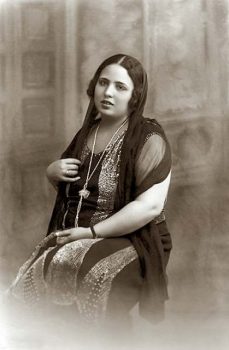
Fat’hiyya
F: yes Fat’hiyya, yet she had no decadent songs. Munira, however, sang decadent songs, and also a very special singer to me, Naima Al-Masriyya. For me, the voice of Naima Al-Masriyya is one of the best female voices in the beginning of the 20th century, and one of her Taqatiq which was famous for being one of the symbols of the decadent musical era was Taala ya Shatir Nerouh El-Anatir. He who listens to this Taqtouqa discovers a very special beauty: on the one hand, the tune itself is really beautiful, and on the other hand, Taala ya Shatir Nerouh El-Anatir has a contrast which I believe is a very intended contrast between the Bayyati melancholic melody and the decadent content of the lyrics. Why is it intended and why is it a contrast? Because the melody is gloomy, while the lyrics imply decadence, and that suggests that the music composer intended to make the listener feel that the lady or girl represented by Naima Al-Masriyya does not believe what she says and that there’s a message beyond the melody that negates or contradicts the content of the lyrics of the song. She knows that she is obliged to say this, nonetheless, through the melody, she makes the listener feel that she doesn’t believe a letter of what she says. This is my own opinion and my analysis of the song. But, in saying “Taala Ya Shatir Nerouh El-Anatir” she neither wants to go to El-Anatir nor does she want to meet the Shatir, I.E, she wants the Shatir to forget about her. “leave me alone, what have I to do with El-Anatar, drinking, working at night, sweating in El-Anatir? No, no, I don’t want to sweat in El-Anatir.”. Her voice while singing in addition to the melody are really beautiful in making the listener feel that all this is fake.
M: Let’s listen to Taala ya Shatir.
[Listen to the whole taqtouqa entitled Taala Ya Shatir Nerouh El-Anatir.].
M: [joking], I swear that while listening to the whole record I searched for Gamal Farid, and I couldn’t find him. [Gamal Farid is the Arabic for “Special Beauty” mentioned above, and these two words in Arabic may indicate a full name.].
F: [Laughing and joking], is it possible that you haven’t heard Gamal Farid here?
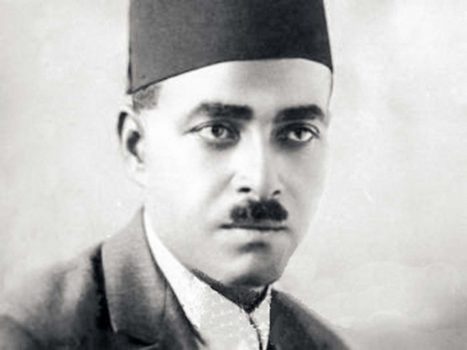
Younis El-Qadi
F: [seriously], Abdel-latif El-Banna’s Taqatiq are also very stunning including Irkhi El-Sitara, and also Munira’s including Matkhafsh Alayya. However, there was a very special phenomenon in the 1920’s: the hostilities between the Fizz and the Turban in the songs especially in the Taqtouqa. There was a repeated theme in several songs: the rotten Faqih, meaning the religious person who is dissolute, I.E, denouncing their alleged hypocrisy. Among these songs which was very famous and successful, and which was heavily criticized and caused a huge campaign against it was Labis Gibba we-Oftan. The lyrics of this song were written by Sheikh Younis El-Qadi. He was appointed as the first censor in Egypt on the artistic works probably to silence him. Though he was the lyricist of the most decadent songs, he was appointed as the head of the authority of censorship of the artistic works.
M: and he confiscated himself.
F: I don’t know whether or not he confiscated himself. Anyway, the records were sold and were already in the market, yet he had to shut up and stop writing similar lyrics. Anyway, this fashion was fading out. Labis Gibba We-Oftan paints the image of a Faqih who is standing in El-Ataba El-Khadra square searching for women to accompany him. He speaks very broken French, and whenever he spots a foreign-looking female, he says: “Bonjour yal-Ghandour” and “A la mode”, “Merci”, “Pardon” and things like that. The song is very beautiful, and though it is very light and comic, it reflects the ideological conflicts in the 1920’s. Let’s listen to it.
[Listen to Labis Gibba We-Oftan sung by Salih Abdel-Hayy.].
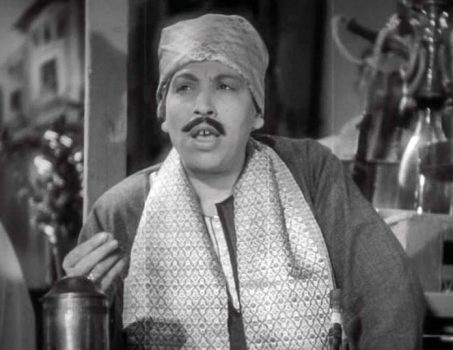
Salih Abdel-Hayy
M: Let’s also listen to Aadi Wa’t El-Bornita, a complete opposite, not from Salih Abdel-Hayy, but from Sheikh Zakariyya himself.
F: This song criticizes the westernization. The criticism is once directed to the “Hat wearers”, another time to the “Turban wearers”, and to the “Fezz wearers”.
M: yes.
[Listen to Aadi Wa’t El-Bornita sung by Sheikh Zakariyya Ahmed.].
End of Episode 1.
- 221 – Zakariyya Ahmed – 12 (1/9/2022)
- 220 – Zakariyya Ahmed – 11 (1/9/2022)
- 219 – Zakariyya Ahmed – 10 (11/25/2021)
- 218 – Zakariyya Ahmed – 9 (10/26/2021)
- 217 – Zakariyya Ahmed – 8 (9/24/2021)
- 216 – Zakariyya Ahmed – 7 (9/4/2021)
- 215 – Zakariyya Ahmed – 6 (8/28/2021)
- 214 – Zakariyya Ahmed – 5 (8/6/2021)
- 213 – Zakariyya Ahmed – 4 (6/26/2021)
- 212 – Zakariyya Ahmed – 3 (5/27/2021)
- 211 – Zakariyya Ahmed – 2 (5/1/2021)
- 210 – Zakariyya Ahmed – 1 (4/28/2021)
- 209 – W-al-Lāhi lā astaṭī‘u ṣaddak 2 (4/6/2017)
- 208 – W-al-Lāhi lā astaṭī‘u ṣaddak 1 (3/30/2017)
- 207 – Bashraf qarah baṭāq 7 (3/23/2017)

